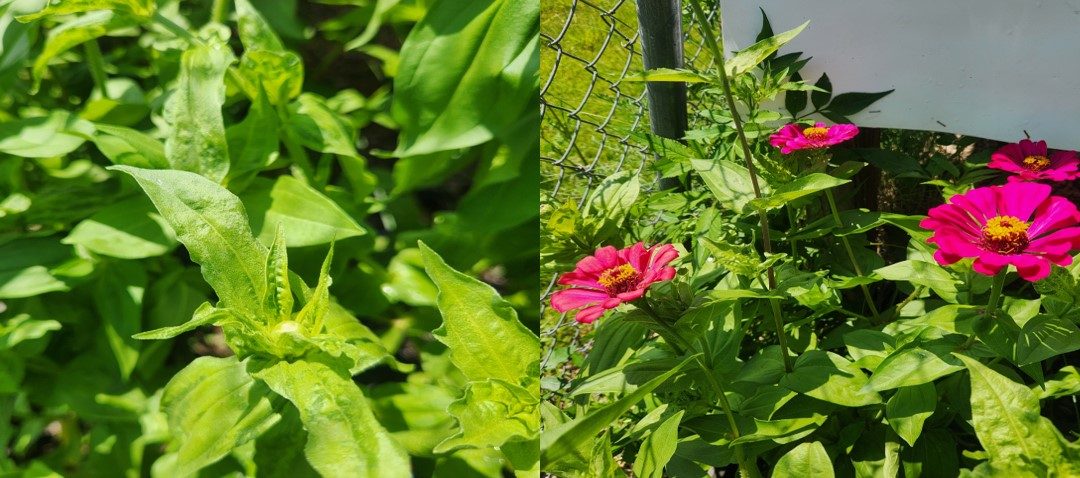
by Donna Arnold | Jul 6, 2025
Zinnia Woes: What’s Causing Terminal Shoot Curling?
On a quiet stroll to the greenhouse early Monday morning, something unusual caught my eye—our zinnia plants looked noticeably different. Their vibrant green shoots had begun to curl at the tips, a subtle but clear sign that all was not well. Do not be alarmed if your zinnias are showing similar symptoms—it is a common issue. Curling at the terminal shoots is often a plant’s way of signaling stress. Whether it is due to environmental factors, pest activity, or nutrient imbalance, these twisted tips are clues worth investigating. Understanding the “why” behind the curl is the first step toward helping your zinnias return to their radiant, blooming selves
Common Culprits Behind Curling Zinnias
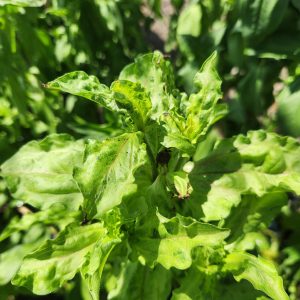
Environmental Stress: Zinnias are sun-lovers, but extreme heat, strong winds, or sudden temperature swings can cause their terminal shoot to curl as a defense mechanism.
Watering Woes: Both overwatering and underwatering can lead to leaf curls. Too much water suffocates roots, while too little causes drought stress—either way, the plant reacts by curling its leaves.
Pests: Aphids, thrips, and spider mites are notorious for feeding on tender new growth. Their sap-sucking habits distort leaves and can transmit viruses.
Diseases: Fungal infections like powdery mildew or bacterial leaf spot can cause curling, especially when combined with poor air circulation.
Nutrient Deficiencies: A lack of nitrogen, magnesium, or manganese can lead to curling and yellowing of new growth. Soil testing can help pinpoint the issue.
What You Can Do:
- Ensure consistent watering—moist but not soggy soil is ideal.
- Inspect regularly for pests and treat with neem oil or insecticidal soap.
- Improve air circulation by spacing plants properly and pruning overcrowded areas.
- Feed with a balanced fertilizer and consider a soil test if symptoms persist.
- Remove and destroy severely affected plants to protect the rest of your garden.
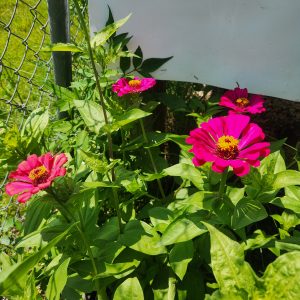
Healthy zinnias reward you with bold, cheerful blooms. A little detective work now can keep your garden dazzling all season long. For more information on Zinnias, contact your local Extension office or follow the links below.
https://gardeningsolutions.ifas.ufl.edu/plants/ornamentals/zinnia/
https://edis.ifas.ufl.edu/publication/FP623
https://nwdistrict.ifas.ufl.edu/hort/category/annuals-2/page/2/#:~:text=When%20planting%20zinnias%2C%20it’s%20recommended,than%20the%20foliage%20whenever%20possible.
by Abbey Smith | Jun 5, 2025
The Florida Panhandle’s warm, humid, and sunny climate makes it ideal for lawns to stay lush and green for most of the year—but it’s also perfect for turfgrass diseases to develop. The summer weather has already been ramping up with temperatures reaching a little above 90 degrees Fahrenheit already this year which also means the signs of disease will be showing sooner rather than later. If you’ve been noticing large brown patches, thinning grass, or strange spots growing on you grass leaves, a disease may already be present. Here’s what you need to know to stay ahead of a total lawn takeover.
Large patch or rhizoctonia blight is one of the most common fungal turfgrass diseases to affect lawns, specifically if you have centipede turfgrass. This disease is most prevalent between the months of November and May, and if not controlled, will continue to spread in the fall. Symptoms are easy to spot, as large, brown circular discolorations that will grow larger in size over time. The best way to treat large patch is through preventative lawn maintenance over time. Water only when necessary to avoid excess moisture, apply slow-release appropriate lawn fertilizers, and clean your mower blades after each time you mow.
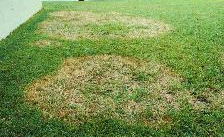
Large patch disease present in turfgrass. Photo Credit: Shelia Dunning, UF/IFAS Extension
Another common lawn disease to see during the warmer months is dollar spot. Dollar spot will affect all warm season turfgrasses but will be more commonly found in Bahia and Bermuda grass. Dollar spot disease creates small patches that are circular and will grow into larger areas. Individual grass leaves will have small lesions starting on the leaf margin that will have a light brown to tan coloration. It is important to know that grasses that are drought stressed, over irrigated, or mowed too low are more prone to contracting this disease. Proper cultivation practices are important to prevent dollar spot and other turfgrass diseases. For more sever cases, the use of chlorothalonil fungicide can be used during the treatment process.
There are various other lawn diseases that can be recognized over time. If you are trying to identify a potential disease in your lawn grass, consider using the UF Turfgrass Disease Identification Flowchart. It will walk you through the symptoms that are present to make a correct diagnosis. If you would like a more expert opinion, contact your local county Extension office for additional help. For additional information on turfgrass diseases, please visit:
https://sfyl.ifas.ufl.edu/media/sfylifasufledu/baker/docs/pdf/horticulture/TurfgrassDiseaseIdentificationGuide.pdf
https://gardeningsolutions.ifas.ufl.edu/lawns/problems-and-solutions/large-patch/
https://gardeningsolutions.ifas.ufl.edu/lawns/problems-and-solutions/lawn-diseases/
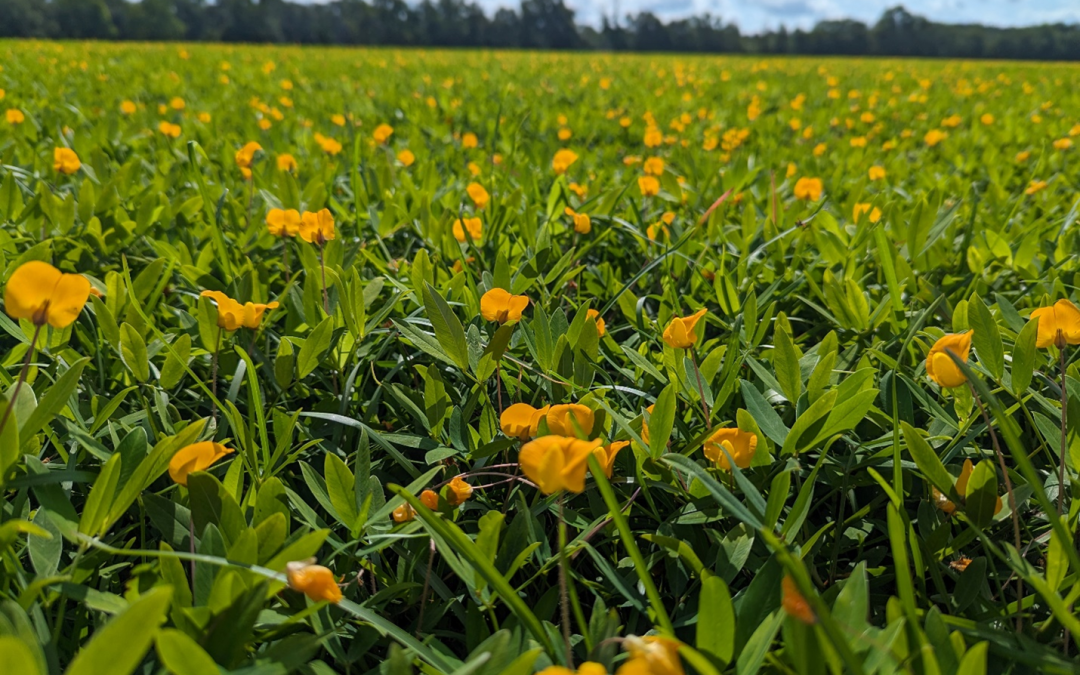
by Dr. Leynar Leyton | Oct 24, 2024
The trend of having a clover lawn, or sometimes called a “fairy” lawn, has gained popularity in the last years. The trend has gained fame as homeowners are more conscientious about the environmental impact of their gardening decisions.
A turfgrass lawn usually requires many inputs to perform at it best: irrigation, fertilization, and regular maintenance (mowing, weed control, etc.). Let’s be clear, turfgrass lawns are not “bad” for the environment per se. In fact, they provide multiple benefits: they control erosion; help with water infiltration; prevent storm water run-off; they reduce noise; and they capture carbon (CO2) from the atmosphere. What gives turfgrass lawns a bad reputation is all the external inputs needed for them to look well maintained and aesthetically pleasing. That is why clover lawns have gained some popularity.
Clover – because of its growth habit – does not require constant mowing. It is also a legume, and as all legumes do, fixes nitrogen into the soil (we may say it produces its own nitrogen fertilizer). Plus, it will have all the other benefits of a turf lawn, or any other plant ground cover: erosion control, water infiltration, storm water control, noise reduction, and CO2 capture into the soil.
There is a superior legume (in my opinion) that can be used as a lawn alternative that unfortunately only grows in warm semi-tropical and tropical climates. But I have good news for you: If you are a Florida resident, you do live in a subtropical or tropical climate!
I am talking about Ornamental Rhizome Perennial Peanut.
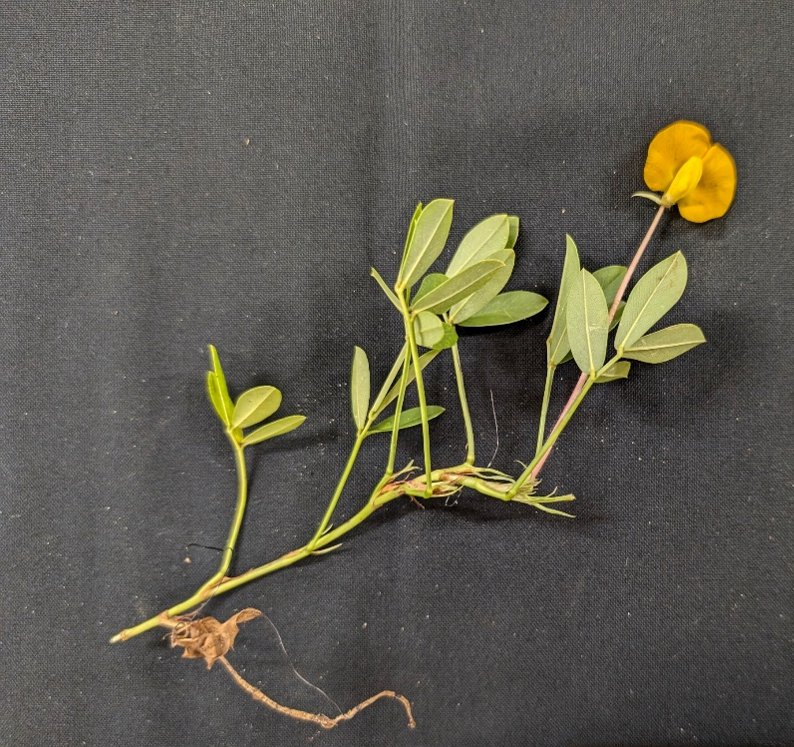
Ornamental Rhizome Perennial Peanut. Photo by Dr. Leynar Leyton, UF/IFAS Ornamental Plant Breeder and Assistant Professor in Environmental Horticulture.
Ornamental Rhizome Perennial Peanut, it is a legume with far superior ornamental and growing habit characteristics than clover. You might be surprised by this statement, as you might heard – or seen- many bad examples of perennial peanut lawns, which give Ornamental Rhizome Perennial Peanut a bad reputation. First, we need to understand that not all peanut plants are the same. Perennial peanut it is not the same peanut that is used for peanut butter or boiled peanuts. Although both are members of the same genus (Arachis) they are different species. Annual peanut (the one that produces peanuts) is Arachis hypogaea. In contrast, perennial peanut does not produce peanuts, and it is a perennial plant (it does not have to be planted each year).
Perennial peanut can be either Arachis glabrata or Arachis pintoi. These two species may look similar, but they are very different. Arachis pintoi, sometimes referred as ‘Pinto peanut’ is a stoloniferous species, which means it produce ‘runners’. Arachis glabrata, in the other hand, produces rhizomes. Rhizomes are underground ‘root’ like structures that store ‘food’ (carbohydrates or starch). I am sure you have seen rhizomes before; some examples include ginger, bamboo, and mint. This is a key difference between Arachis pintoi and Arachis glabrata.
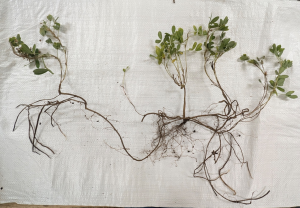
Rhizomes in rhizome perennial peanut (Arachis glabrata). Photo by Dr. Leynar Leyton, UF/IFAS Ornamental Plant Breeder and Assistant Professor in Environmental Horticulture.
The rhizomes of Arachis glabrata give it an outstanding characteristic: drought resistance. Once Arachis glabrata gets established, and the rhizomes have had time to store nutrients and starch, the plant can resist long periods of drought. This does not mean that the plants will look ‘perfect’ under long periods of drought, but that it will survive and come back after it gets water again. The stoloniferous types (Arachis pintoi) lack the drought resistance, although they can be somewhat drought tolerant, but they will tolerate some flood conditions.
Another important characteristic to look for in Ornamental Rhizome Perennial Peanut is the cultivar that you are buying. There are many forage types of rhizome perennial peanut, and you do not want those. Forage types are “taller”, between 6 to 18 inches tall, and were selected for their ability to produce biomass. Ornamental cultivars of rhizome perennial peanut are much smaller (less than 4 inches tall). That is why I have been intentionally calling it “Ornamental Rhizome Perennial Peanut”. That is the key to have a beautiful perennial peanut lawn: using a rhizome, ornamental type of perennial peanut. Rhizome Perennial Peanut performs better in full sun, and in well drained soils. In heavier soils, rhizome perennial peanut will grow at a lower rate. And rhizome perennial peanut already grows a bit slower for the liking of some people (let’s remember that rhizome perennial peanut plants are not only growing green leaves above ground, but also storing nutrients and starch into the rhizomes underground). In average, rhizome perennial peanut will grow about 6 inches per growing season with good growing conditions. This is an important consideration when you establish rhizome perennial peanut. Rhizome perennial peanut also produces beautiful orange flowers, that attract pollinators.
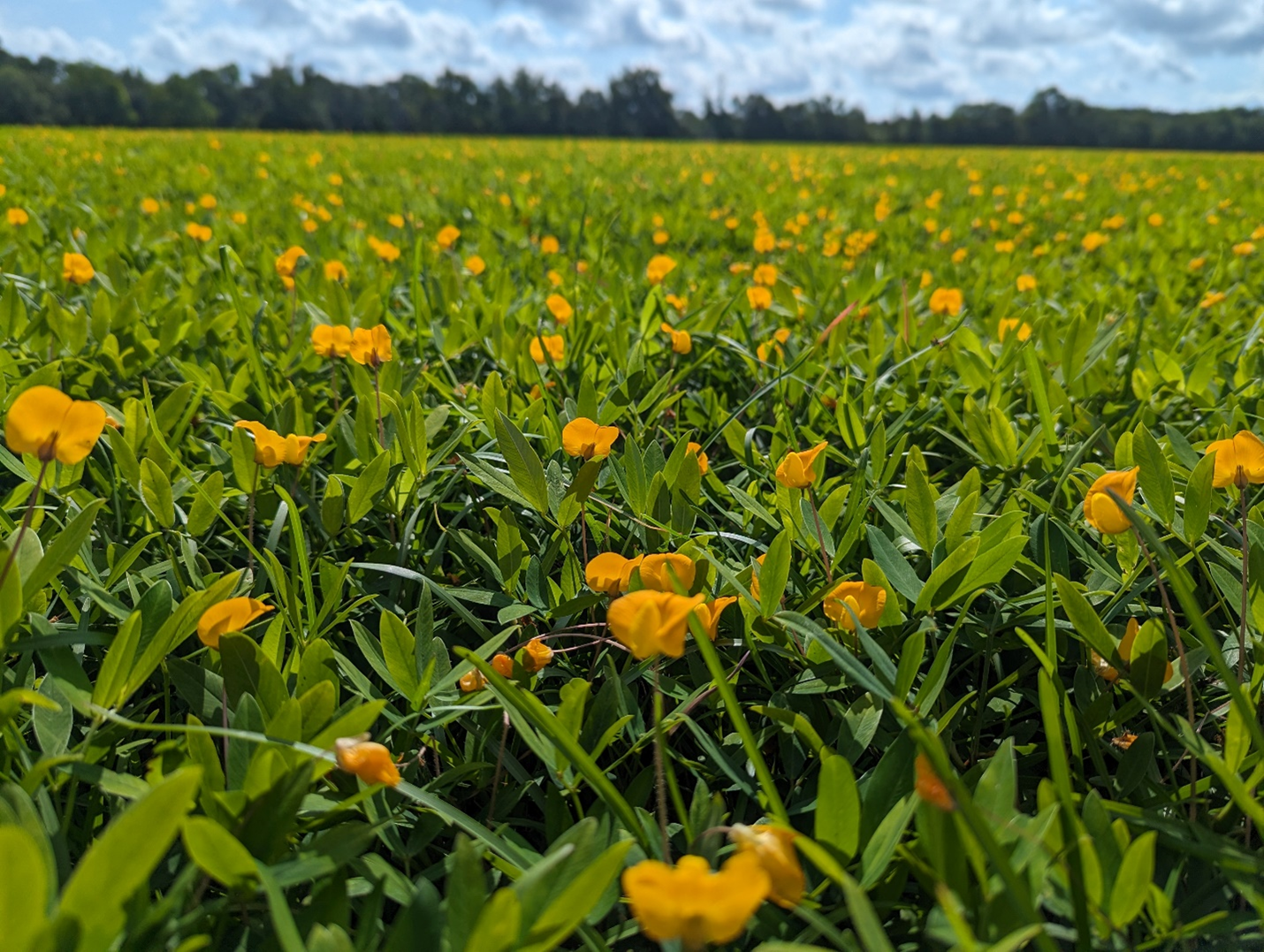 Ornamental Rhizome Perennial Peanut A. glabrata ‘Ecoturf’ in North Florida. Picture by Dr. Leynar Leyton, UF/IFAS Ornamental Plant Breeder and Assistant Professor in Environmental Horticulture.
Ornamental Rhizome Perennial Peanut A. glabrata ‘Ecoturf’ in North Florida. Picture by Dr. Leynar Leyton, UF/IFAS Ornamental Plant Breeder and Assistant Professor in Environmental Horticulture.
One of the most popular cultivars of Ornamental Rhizome Perennial Peanut are ‘Ecoturf’, ‘Cowboy’, ‘Waxy Leaf’ and ‘Needlepoint’. You might see ‘Golden Glory’ sometimes described as a rhizome type, but it is not. ‘Golden Glory’ is a stoloniferous type (Arachis pintoi) and it does not perform well. Our UF/IFAS Ornamental Perennial Peanut Breeding Program will release some new varieties of Ornamental Rhizome Perennial Peanut soon, but I’ll tell you more about that in the upcoming months. Stay tuned!
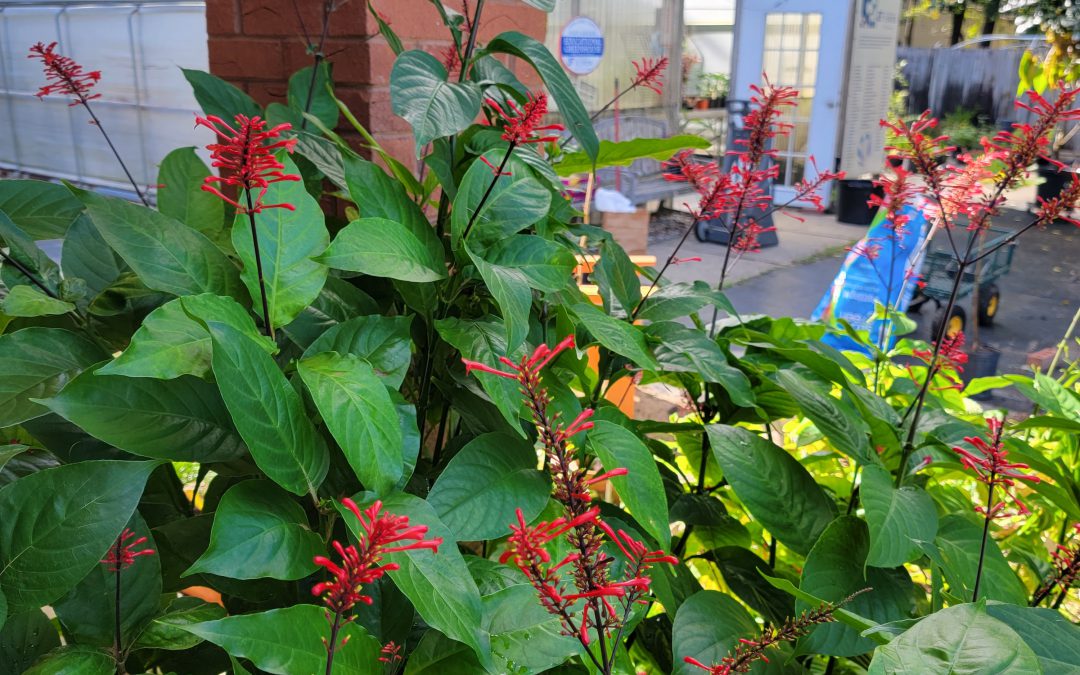
by Sheila Dunning | Sep 30, 2024
Looking to add something to brighten your landscape this autumn? Firespike (Odontonema strictum) is a prolific fall bloomer with red tubular flowers that are very popular with hummingbirds and butterflies. It’s glossy dark green leaves make an attractive large plant that will grow quite well in dense shade to partial sunlight. In frost-free areas, firespike grows as an evergreen semi-woody shrub, spreads by underground sprouts and enlarges to form a thicket.
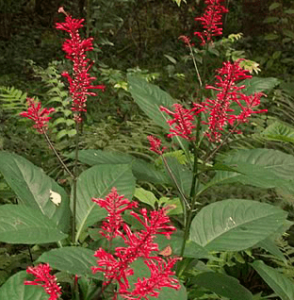
Bright red blooms of Firespike
In zones 8 and 9 it usually dies back to the ground in winter and resprouts in spring, producing strikingly beautiful 9-12 inch panicles of crimson flowers beginning at the end of summer and lasting into the winter each year. Firespike is native to open, semi-forested areas of Central America. It has escaped cultivation and become established in disturbed hammocks throughout peninsular Florida, but hasn’t presented an invasive problem. Here in the panhandle, firespike will remain a tender perennial for most locations. It can be grown on a wide range of moderately fertile, sandy soils and is quite drought tolerant. Firespike may be best utilized in the landscape in a mass planting. Plants can be spaced about 2 feet apart to fill in the area quickly. It is one of only a few flowering plants that give good, red color in a partially shaded site. The lovely flowers make firespike an excellent candidate for the cutting garden and is a “must-have” for southern butterfly and hummingbird gardens. Additional plants can be propagated from firespike by division or cuttings. However, white-tailed deer love firespike too, and will eat the leaves, so be prepared to fence it off from “Bambi”.
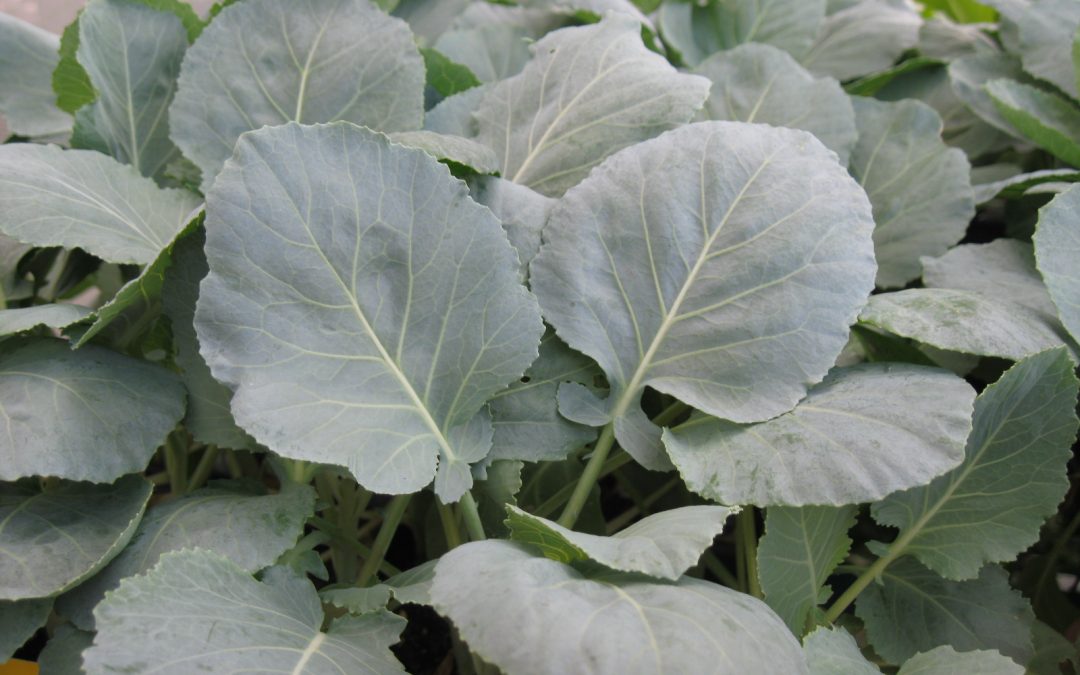
by Julie McConnell | Sep 19, 2024
UF/IFAS Extension Agents from across the Florida Panhandle had a great discussion about fall vegetable gardening in the latest episode of Gardening in the Panhandle LIVE! Fall Vegetable Gardening on September 12th. As usual, we had a great bank of questions supplied by our viewers and we want to follow up by sharing a recap of the discussion with reference links so you can dig deeper into the recommendations they provided.
These references are in the order they were mentioned on the video which can be found at https://youtu.be/Dt4kMK08LCM?si=rsXLHZ6lTdFkJzf1
Our last Gardening in the Panhandle LIVE! of 2024 will be on October 10th and the topic is Vermicomposting and Composting. Register to join us on Zoom at https://ufl.zoom.us/webinar/register/9717023978670/WN_5LMDotSeTJqfqcS6vIVM2Q
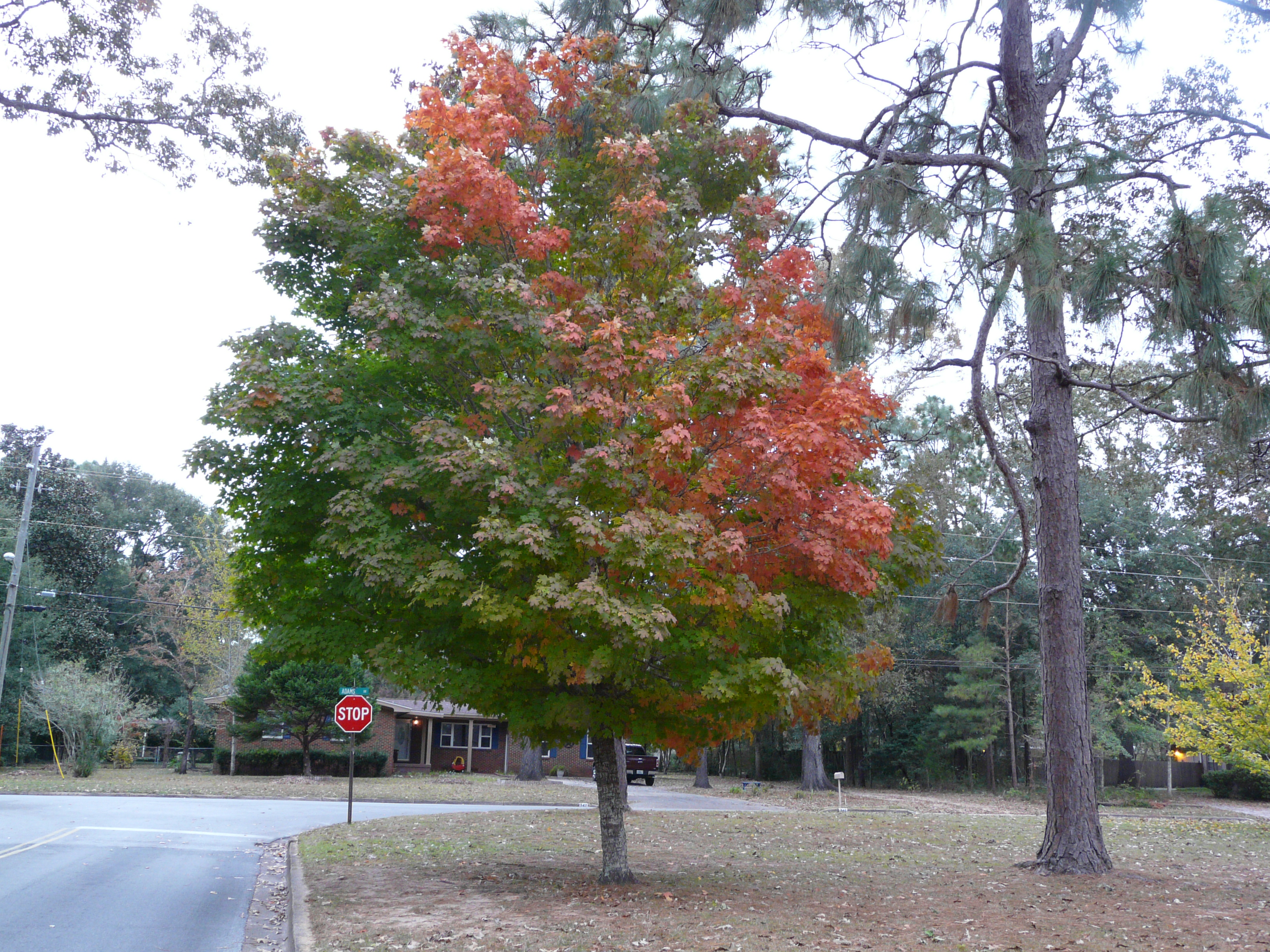
by Ray Bodrey | Sep 4, 2024
Fall is a season that is synonymous for two great joys in life…..football games and the changing leaf colors! However, in Florida we just don’t have the incredible burst of vivid fall leaf color as our northern neighbors enjoy each year, but we do have enough temperate region plants that can give us some seasonal change in foliage.
So what makes this brilliant display of autumn leaf color anyway? This seasonal change is brought on by a few variables, such as lower temperatures, shorter photo period/shorter days and chemical pigments found in leaf tissues. Some of the pigments that give autumn leaves their bright colors are actually present in the leaves as soon as they unfold as flush in early spring. But, during spring and summer, when the plants are growing vigorously, a green-colored material called chlorophyll dominates and shades out the other leaf pigments.
Chlorophyll plays on important role in a process called photosynthesis, which is the process by which plants capture energy from sunlight and manufacture food. Chlorophyll can also be found in water bodies and is an indicator of water quality. As plants get ready for cool season dormancy, the production on new chlorophyll decreases to almost being nonexistent. That’s when the before mentioned pigments, also called carotenoids, take over and make the leaves turn brilliant orange, red, purple and yellow.
There are some plants in the Florida’s landscape that do provide good fall color. Unlike most of the flowering shrubs, which hold their blossoms for only a brief period, the trees and shrubs that turn color in the fall will usually retain their varied hues for a month or more, depending on the weather.
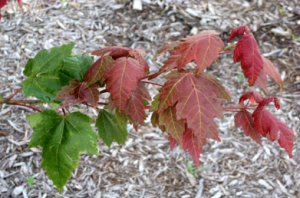
Red Maple. Credit. UF/IFAS Extension
What are some examples of trees that will lend fall color in your Panhandle landscape?
- Shumard Oak
- Turkey Oak
- Ginkgo
- Hickory
- Golden Rain Tree
- Red Swamp Myrtle
- Dogwood
- Red Maple (see photo)
- Sweet Gum
- Black Gum
- Crape Myrtle
- Tulip Tree
- Bradford Pear
- Cypress
What about annuals that provide color in the fall? Petunias, pansies and snapdragons will be in full bloom over the next few months.

Firespike. Credit. UF/IFAS Extension
What about blooming perennials for fall? Salvia, firespike (see photo), chrysanthemum, beautyberry and holly are great for color in the fall and attract wildlife to your landscape.
A mix of these plants will ensure fall color in your landscape. For more information contact your local county extension office.
Information for this article was provided by Patrick Minogue, Forestry Specialist with UF/IFAS North Florida Research and Education Center, as well as the UF/IFAS Gardening Solutions: https://gardeningsolutions.ifas.ufl.edu/design/outdoor-living/gardening-for-fall-color/













